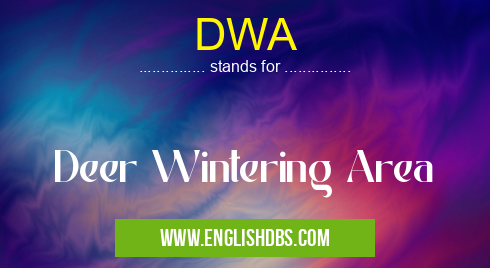What does DWA mean in UNCLASSIFIED
In the realm of natural resource management, the abbreviation DWA stands for Deer Wintering Area. DWAs are designated areas that provide critical habitat for deer during the winter months, when food and shelter are scarce.

DWA meaning in Unclassified in Miscellaneous
DWA mostly used in an acronym Unclassified in Category Miscellaneous that means Deer Wintering Area
Shorthand: DWA,
Full Form: Deer Wintering Area
For more information of "Deer Wintering Area", see the section below.
DWA Meaning and Purpose
Deer Wintering Areas serve several important purposes:
- Provide Food: DWAs contain abundant vegetation that deer rely on for sustenance during the winter when natural forage is limited.
- Offer Shelter: DWAs offer shelter from harsh weather conditions such as snow, wind, and cold, allowing deer to conserve energy and avoid excessive heat loss.
- Minimize Competition: DWAs help reduce competition for food and shelter among deer, promoting their overall health and survival.
- Facilitate Management: DWAs provide a designated area for wildlife management practices, such as population monitoring, habitat improvement, and controlled hunting.
Characteristics of DWAs
DWAs typically possess the following characteristics:
- Coniferous Forests: Often located in coniferous forests, which provide dense cover and thermal protection.
- Openings and Meadows: Contain openings or meadows that provide access to forage and facilitate movement.
- Proximity to Water: Located near water sources, which are essential for deer hydration and thermoregulation.
- Limited Disturbance: Minimal human activity or development to ensure deer have a safe and undisturbed winter habitat.
Essential Questions and Answers on Deer Wintering Area in "MISCELLANEOUS»UNFILED"
What is a Deer Wintering Area (DWA)?
A DWA is a designated area where deer congregate during the winter months to find food and shelter. These areas provide vital habitat for deer during critical periods when food resources are limited.
Why are DWAs important?
DWAs protect deer from starvation and exposure by providing access to food and shelter during the harsh winter conditions. They also help maintain healthy deer populations by ensuring sufficient nutrition and reducing the risk of disease transmission.
How are DWAs managed?
DWAs are typically managed by state or federal wildlife agencies. Management practices may include habitat improvements, such as planting food sources or creating shelter, as well as regulating human activities to minimize disturbance to deer.
What are the benefits of DWAs for humans?
DWAs provide indirect benefits for humans by supporting healthy deer populations. Deer are an important ecological component, contributing to biodiversity and providing recreational opportunities such as hunting and wildlife viewing.
How can I find out if there are DWAs in my area?
Contact your local wildlife agency or search online for DWA maps or databases. These resources can provide information on the location and size of DWAs in your region.
Final Words: Deer Wintering Areas play a crucial role in supporting deer populations during the challenging winter months. By providing food, shelter, and minimizing competition, DWAs contribute to the overall health and sustainability of deer herds. Understanding the meaning and purpose of DWAs is essential for effective wildlife management and conservation efforts.
